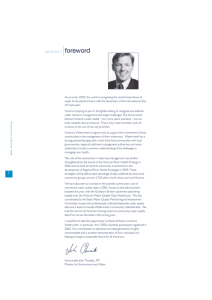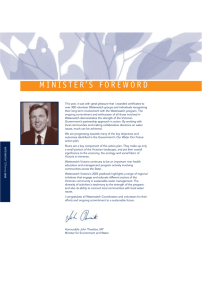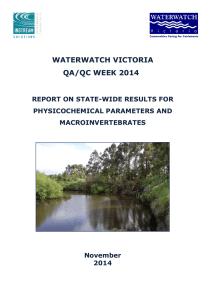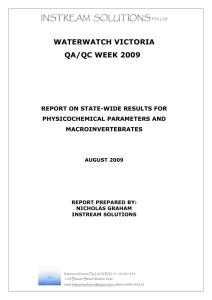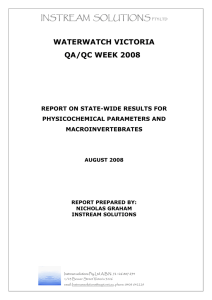WATERWATCH VICTORIA QA/QC WEEK 2011 REPORT ON STATE-WIDE RESULTS FOR
advertisement
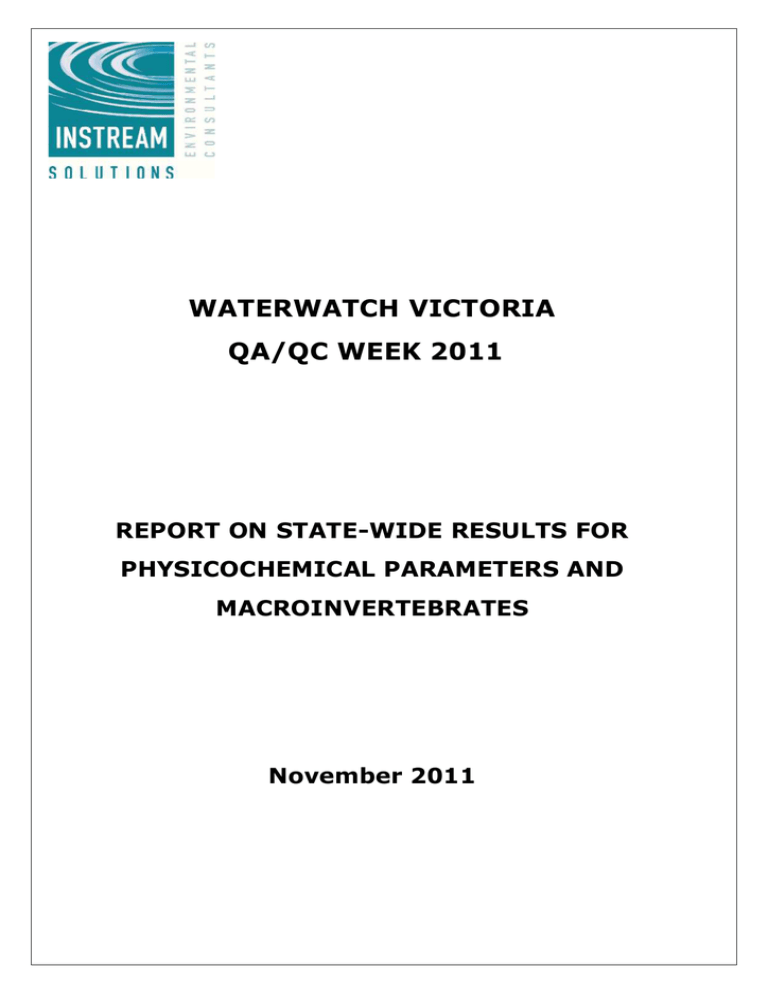
WATERWATCH VICTORIA QA/QC WEEK 2011 REPORT ON STATE-WIDE RESULTS FOR PHYSICOCHEMICAL PARAMETERS AND MACROINVERTEBRATES November 2011 1.0 Background Waterwatch Victoria is a state-wide community based water quality monitoring organisation that aims to increase local community understanding and ownership of waterway and catchment issues. Community volunteers and Waterwatch coordinators are involved in the monitoring of waterway health, including water quality and macroinvertebrate indicators. Waterwatch Victoria’s QA/QC Week program is an annual event co-ordinated at a state-wide level. It involves the testing of laboratory prepared standard samples by monitors and coordinators to ensure that their equipment and monitoring techniques are accurate. For more information on Waterwatch Victoria’s Data Confidence Framework, guidelines and data confidence plans, visit www.vic.waterwatch.org.au This report provides a simple summary of the state-wide data provided by both co-ordinators and monitors during QA/QC Week 2011. It follows on from similar programs that have been conducted annually since 1998. Further detail can be found within the eight regional reports that have been distributed to the Waterwatch coordinators. 2.0 Methods 2.1 Physico-chemical Parameters Stable ‘Mystery’ reference water samples were prepared for pH, electrical conductivity (EC), turbidity and orthophosphate by Australian Chemical Reagents (Roach Analysts), QLD. Each parameter was further divided into a low range sample (A) and a high range sample (B) giving a total of 8 unique samples. A subset of these samples (approximately 10%) was tested by a NATA accredited laboratory to check for sample homogeneity and stability. Physicochemical ‘mystery’ solutions were prepared to specifications recommended by the state Waterwatch Victoria office. Values listed in Table 1 are the averaged solution concentrations of the subset measured during QA/QC Week. Individual parameter solutions were provided to all regions in separate bottles with labelled instructions for sample preservation and use. Acceptable upper and lower quality control limits for each parameter were set according to the standards outlined in the Waterwatch Victoria Data Confidence Framework. These quality control limits are sensitive to the wide array of equipment used by Waterwatch coordinators and monitors. As with previous years there was again an issue relating to the measurement of orthophosphate samples using the colour comparators. In light of this issue, the Waterwatch Victoria QA/QC Week 2011 1 acceptable range for the low range parameter was maintained at 40% as was the case in 2010. Table 1. True values and acceptable limits for phys-chem parameters. Parameter pH (pH units) EC (µS/cm) Turbidity Meter (NTU) Turbidity Tube (NTU) Orthophosphate mg/L Sample Acceptable Range True Value Lower Limit Upper Limit A ± 0.3 6.2 5.9 6.5 B 8.8 8.5 9.1 A ± 0.3 ± 10% 440 396 484 B ± 10% 6200 5580 6820 A ± 20% 18 14 22 B ± 20% 55 44 66 A ± 25% 18 14 23 B ± 25% 55 41 69 A ± 40% 0.04 0.024 0.056 B ± 20% 0.4 0.32 0.48 A total of 1368 phys-chem samples were sent out across the state for QA/QC Week 2011. Two hundred and sixty one participants took part in the event including 21 coordinators and 240 monitors. Please note that not every participant attempted all eight samples as regional co-ordinators decided which samples they, and their monitors, would assess prior to QA/QC Week 2011. The minimum number of samples assessed by any one participant was two, with the majority assessing between four and seven. All participants were provided with event codes to allow their results to be included in the state-wide analysis anonymously. The Victorian Waterwatch Data Confidence Framework sets out minimum requirements for equipment to be used by monitors and co-ordinators to conduct water quality analysis. A summary of the requirements for monitoring Standards 3 and 4 is provided in Table 2 below. Table 2. Minimum requirements outlined in the Data Confidence Framework. Parameter Standard 3 Standard 4 EC Low range = minimum resolution of 0.10 mS/cm High Range = minimum resolution of 10 mS/cm Low range = min resolution of 0.10 mS/cm High Range = minimum resolution of 10 mS/cm pH pH meters (not strips) pH meters (not strips) Turbidity Turbidity tubes Turbidity meter P04 Comparator Colorimeter Waterwatch Victoria QA/QC Week 2011 2 2.2 Macroinvertebrates A total of 70 ‘Mystery’ macroinvertebrate samples of known taxonomic composition were prepared by Instream Solutions. These samples were provided to test the co-ordinators and monitors identification skills at variable taxonomic resolutions. The ‘mystery’ samples consisted of six macroinvertebrates that are naturally found in the majority of Victorian bioregions so not to disadvantage participants (Table 3). Coordinators and monitors were asked to identify the macroinvertebrates at the Order, Family and common name level. Table 3. Macroinvertebrate “Mystery Sample” taxa list. Order Family Common Name Trichoptera Calamocertidae Sleeping Bag Caddis Trichoptera Leptoceridae Walking Stick Caddis Coleoptera Psephenidae Water Penny Coleoptera Elmidae Riffle Beetle Ephemeroptera Leptophlebiidae Odonata Gomphidae Mudeyes, Dragonfly larve Waterwatch Victoria QA/QC Week 2011 Found in Victorian Bioregions Highlands, Forest A, Forest B, Cleared Hills and Coastal plains Highlands, Forest A, Forest B, Cleared Hills and Coastal plains Highlands, Forest A, Forest B, Cleared Hills and Coastal plains Highlands, Forest A, Forest B, Cleared Hills and Coastal plains Highlands, Forest A, Forest B, Cleared Hills and Coastal plains Highlands, Forest A, Forest B, Cleared Hills and Coastal plains 3 3.0 Results 3.1 Physicochemical The following table summarises the co-ordinators results across all of the eight regions. A 100 percent pass rate was achieved for the high range (sample B) electrical conductivity sample and for both turbidity samples. Table 4. Co-ordinator pass rates for physicochemical parameters. Parameter Sample pH (pH units) EC (µS/cm) Turbidity (NTU) Orthophosphate mg/L A B A B A B A B Number of results (n) 17 15 17 12 19 12 18 10 Pass Rate % 88 93 94 100 100 100 66 70 2010 Pass Rate % 100 100 100 100 88 100 100 100 As can be seen in Figure 1 the coordinator results in 2011 were slightly lower than those recorded in 2010 and were in fact very similar to the results from 2009. Figure 1. Comparison of Co-ordinator pass rates between 2010 and 2011. Coordinator Comparison 2010 - 2011 120 % Pass Rate 100 80 2011 60 2010 40 20 0 pH A pH B EC A EC B Turb A Turb B Waterwatch Victoria QA/QC Week 2011 PO4 A PO4 B 4 State-wide results for the monitors are summarised in Table 5 below. Table 5. Monitor pass rates for physicochemical parameters. Parameter Sample pH (pH units) EC (µS/cm) Turbidity (NTU) Orthophosphate mg/L A B A B A B A B Number of results (n) 174 121 201 101 207 111 176 53 Pass Rate % 95 87 92 88 80 75 71 70 2010 Pass Rate % 92 87 86 85 86 88 71 62 A comparison between pass rates in 2010 and 2011 suggests that monitors accuracy slightly increased for the pH A and Electrical Conductivity parameters. A small decrease in pass rates was observed for both turbidity parameters. Figure 2. Comparison of monitor pass rates between 2010 and 2011. Monitor Comparison 2010 - 2011 100 90 80 % Pass Rate 70 60 50 2011 40 2010 30 20 10 0 pH A pH B EC A EC B Turb A Turb B Waterwatch Victoria QA/QC Week 2011 PO4 A PO4 B 5 A comparison between the performance of the co-ordinators and that of the monitors, in 2011, is provided in figures 3 and 4 below. For the low range samples the monitors had surprisingly higher pass rates for both the pH and ortho-phosphate samples. Figure 3. 2011 Pass rates for coordinators and monitors – Low Range Low Range Sample A 120 % Pass Rate 100 80 Coordinators 60 Monitors 40 20 0 pH A EC A Turb A PO4 A Results for the high range parameters were more in line with expectations and coordinators pass rates were consistently higher when compared with the monitors’ results. Figure 4. 2011 Pass rates for coordinators and monitors – High Range High Range Sample B 120 % Pass Rate 100 80 Coordinators 60 Monitors 40 20 0 pH B EC B Turb B Waterwatch Victoria QA/QC Week 2011 PO4 B 6 3.2 Macroinvertebrates Twelve coordinators and twenty eight monitors attempted to identify the macroinvertebrate ‘Mystery samples’. Bugs were identified by eye, hand lens or microscope, using a variety of macroinvertebrate keys and picture books. The majority of co-ordinators and approximately half of the monitors attempted to identify the bugs at family level. Pass rates were generally quite good, with the co-ordinators having a slightly higher overall pass rate than the monitors. As with last year there were several macroinvertebrates included in the vials that can be difficult to identify. The features used to distinguish Calamocertidae, Leptoceridae and Elmidae from other families are typically small and best observed under a microscope. A list of common misidentifications made by participants in QA/QC week 2011 are outlined in the table below. Table 7. Common misidentifications at family level Macroinvertebrate Common Mistakes Calamoceratidae Ecnomidae, Hydropsychidae Leptoceridae Philopotamidae Psephenidae Elmidae Hydrophilidae, Hydraenidae Leptophlebiidae Baetidae Gomphidae Aeshnidae, Telephlebiidae Identification of macroinvertebrates at family level can be difficult. There are a number of ways individual regions can improve their identification accuracy if they wish to, including; purchasing stereo microscopes, obtaining appropriate family level keys and participating in macroinvertebrate training seminars. Waterwatch Victoria QA/QC Week 2011 7 5.0 Conclusion The annual QA/QC Week, which is conducted across the state, is just one quality control check provided by Waterwatch Victoria to support volunteer monitors and co-ordinators. This year over 260 data sheets for phys-chem and 52 data sheets for macroinvertebrates were received for analysis. Pass rates for samples were generally high with the exception again being the orthophosphate results. A comparison between the 2011 and 2010 results revealed that overall the pass rates for both monitors and co-ordinators are relatively stable. As was the case with previous years, several issues relating to the use of equipment were discovered when processing the data from QA/QC Week 2011.. Many level 4 co-ordinators and monitors are still using turbidity tubes and colour comparators when according to the Data Framework they should be using turbidity meters and colorimeters. It is suggested that if these participants were to use the appropriate equipment (which is more accurate when used correctly) many of their pass rates would improve. On a positive note the number of level 3 and 4 participants using pH strips instead of pH meters has declined considerably. Appendix 1: Data Raw data from QA/QC Week 2011 can be accessed in excel spreadsheet format upon request from Waterwatch Victoria. Waterwatch Victoria QA/QC Week 2011 8
